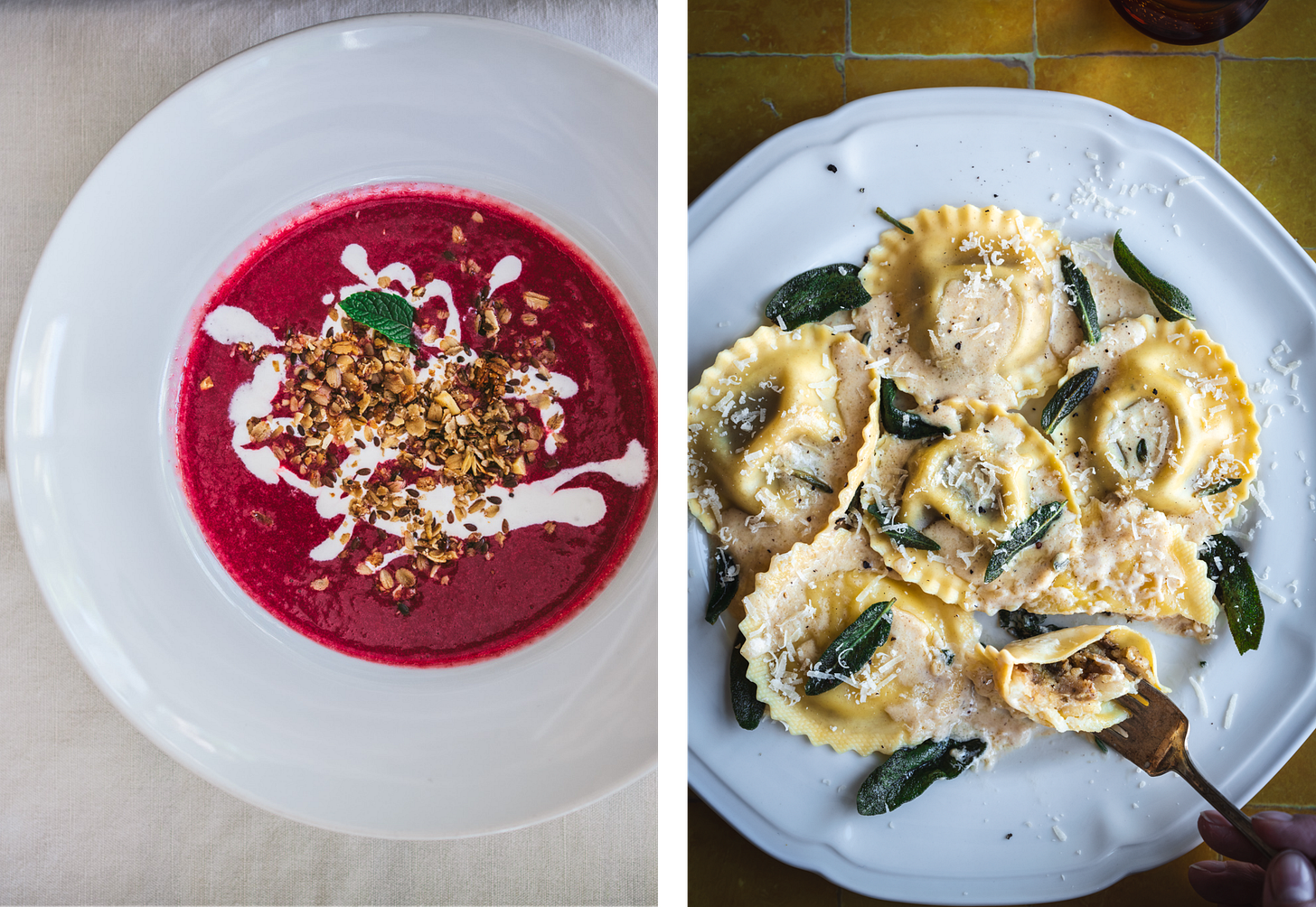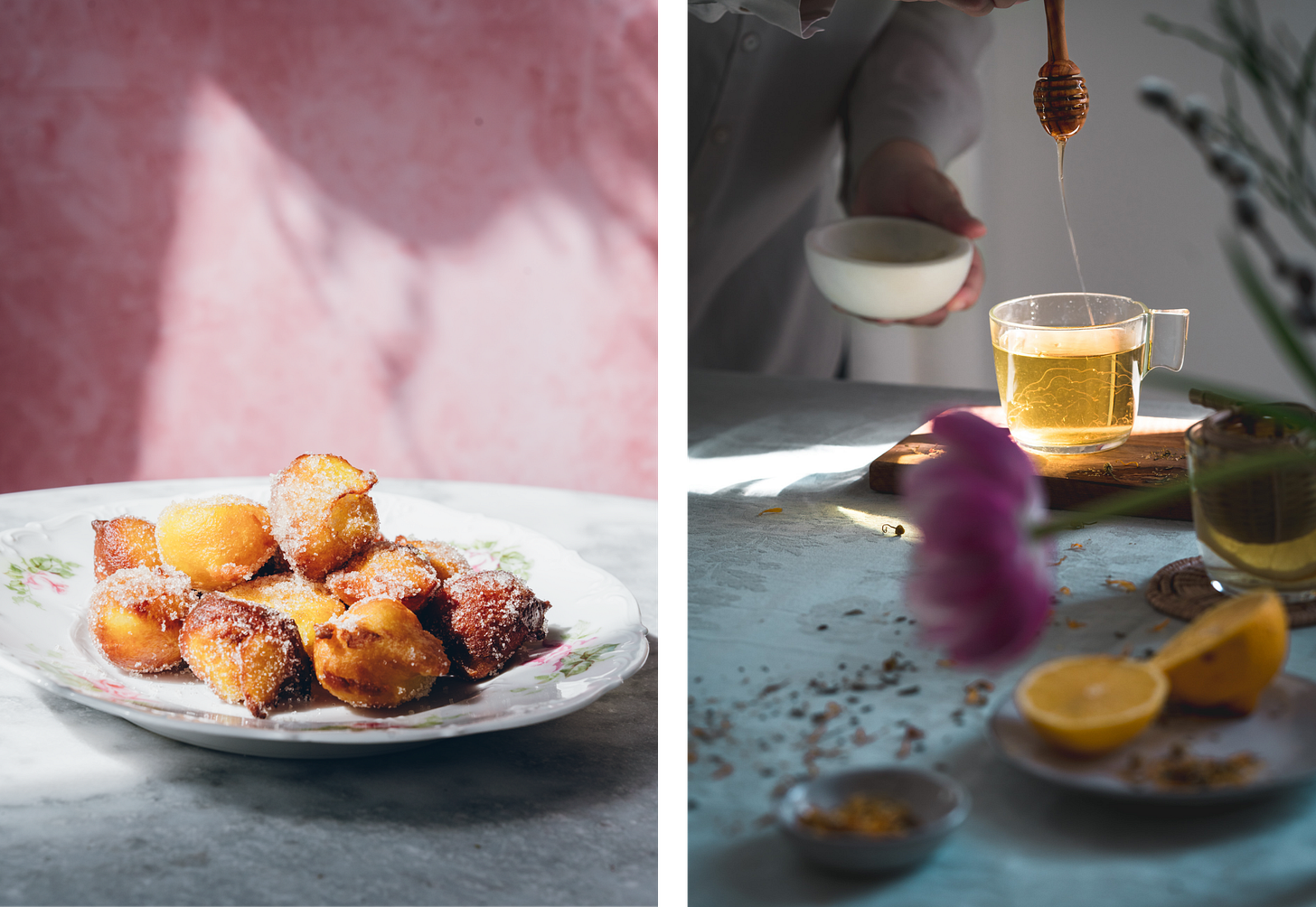Today’s Photography Newsletter will be the second issue of a quarterly series I’ve started this year. We have been talking about some fundamentals of photography — with a focus on food— but I thought I could give you some more insight on the particularities and nuances of each season.
Catch up with some basic notions and with winter’s issue here first:
The images below have been taken by me (styled, shot and edited) with my Sony camera, unless stated otherwise.
Spring’s Vibrant Spirit in Food Photography
As the days grow longer and nature awakens, spring brings an abundance of fresh, vibrant ingredients to the table. The season’s light, bright colors and tender textures create a lively and refreshing mood for photography. It may sound cliché but it’s very true that nature awakens and we feel revitilised by it!
You may be lucky and be surrounded by blooming flowers or green fields, but even if you are not, you can bring the essence of the season to your images. With the right techniques for working with natural light and styling your dishes, you can transform simple meals into vibrant, seasonal photographs.
In this issue, I’ll show you how to best photograph the essence of spring, focusing on fresh ingredients, natural light, and the lively beauty of the season.

How to Style your Spring Food Scenes
Spring is all about fresh, clean, and light vibes. Think of your styling as a way to highlight the feelings the season evoque.
Create Layers
To add depth and interest to your food photography, it’s important to create layers in your composition. Layering food items thoughtfully, whether stacking ingredients or arranging them in a slightly disordered yet intentional way, creates visual texture that draws the eye. A salad with its greens, nuts, and fresh herbs layered on top of one another instantly looks more dynamic than a flat arrangement. For desserts like fruit tarts or cakes, capturing the layers of fruit, cream, and pastry can tell a story of complexity.
A “messy yet intentional” look works great with fresh spring dishes. Take a vibrant fruit salad, for example—don’t just pile it in a perfect circle; let the fruits tumble out slightly, creating a relaxed yet curated feel. Similarly, with springtime desserts, don’t be afraid to let things look a bit more natural.
The layering of textures, whether it’s the smoothness of cream, the crunch of fresh herbs, or the softness of roasted vegetables, adds depth and a sense of visual interest that makes your food feel alive and full of energy.

Use Seasonal Touches
Spring is the perfect time to embrace the vibrant, fresh greens that are so abundant in this season. Incorporating herbs like basil, mint, or rosemary into your food styling adds a touch of life and texture that brings your dish to life. As long as they make sense in your recipe, a sprig of rosemary or a handful of microgreens can instantly elevate the aesthetic of your plate, creating a sense of freshness that feels natural and effortless.
These small but powerful touches help highlight the lightness of spring meals, and create one more layer. They can be placed on top of the dish itself, or on the table as styling and a cue on what’s on the plate.
Add Natural of Props
To complement the freshness of spring ingredients, focus on using simple, natural textures that allow the food to be the star. Think about using lightweight fabrics, soft linens, and wood or natural stone materials to keep the scene feeling fresh and light. A handmade ceramic bowl, a wooden cutting board, or a pastel toned plate allows the colors of your food to stand out and brings warmth and charm to the scene.
For an extra seasonal touch, incorporate soft floral patterns in tablecloths or napkins, or place a fresh bouquet of spring flowers —such as tulips, daisies, or lavender— in the background or on the table for an added pop of color and texture.

If you're photographing drinks or desserts, clear glass mugs, pitchers, or bowls can showcase their vibrant colors (think fresh lemonade or spring cocktails!).
And don’t forget about the clothing or accessories you use in your scene—since spring is often a time of renewal, a light sweater, denim apron, or even bare arms (if it’s warm enough) can add a natural, relaxed feel. Just be mindful that your props and styling reflect the season’s ease, while not distracting from the freshness and vibrancy of the food.

Embrace the Natural Light
Finally the long awaited spring days have arrived and we have more light to use as days are longer. The season brings soft, diffused light, which creates the perfect atmosphere for capturing vibrant, fresh food.
Soft light
As I mentioned in different previous newsletters, diffused light is our friend for food photography. It illuminates the scene evently without creating harsh lines between the shadow areas and the highlighted ones, letting all the attention go the plate. Spring naturally has soft days in which is partially cloudy —which means the light is already coming to us diffused from the sky!. But in case you need to photograph your dish in a sunny day, you can position your setup near a window with sheer curtains or a light fabric to gently filter the sunlight.
The diffused light enhances the freshness of spring ingredients—whether it’s the vibrant green of leafy herbs, the delicate sheen of a fruit glaze, or the soft textures of a spring dessert. This kind of light works especially well with lighter, airier foods, creating a balanced, fresh look that captures the essence of the season.
Hard light
It’s true that direct sunlight can often be too harsh, casting strong shadows and distorting the true colors of your food. Bright, direct light can create areas of intense contrast that can draw attention away from the details you want to highlight. But… it can also be absolutely gorgeous! See Sarah’s photos (
) as perfect examples on how pretty these images can be.Hard light can create a lot of interest visually as not many people dare to play with it — for the previous reasons mentioned. Post-editing may help compensate the very dark areas (shadows) and the very light areas (highlights), so it’s a bit softer and harmonized. But I say, play with it and experiment!
How to Frame your Food
When it comes to food photography, how you frame your subject is just as important as what you're photographing. The way you arrange your shot can dramatically affect how your food looks, making it more appealing and helping it stand out in its best light. Think about what’s the highlight of your dish before deciding where to position your camera (or phone) in respect of the subject. Experiment with different angles to find its most flattering view.
Top-down Shots
One of the most popular and effective ways to capture food is from a top-down perspective, especially for dishes that are colorful or have a variety of elements, and are best seen flat. Think a vibrant spring salad, a brunch spread with eggs, toast, and fresh fruit, or a picnic-style assortment of cheeses, crackers, and veggies. This angle allows you to showcase all the layers, textures, and colors of your dish, offering a comprehensive view that makes everything feel abundant and inviting.
Close-ups
Sometimes, it’s the little details that truly capture the essence of spring. Close-up shots allow you to focus on the textures that make spring ingredients so special.
This type of shot is perfect for showcasing textural contrast—the delicate crispness of spring greens against the smoothness of a creamy dressing, or the natural shine of fresh citrus on a spring dessert. Close-ups can also highlight smaller ingredients that might otherwise get lost in a wider shot, but they will also highlight any “imperfections”, so make sure everythings looks good up close!
Play with Balance and Movement
The beauty of food photography lies in how you choose to arrange your subject—and spring dishes offer the perfect opportunity to experiment with both symmetry and asymmetry.
Symmetry can create a clean, orderly look, often used in dishes like a perfectly arranged fruit tart or sliced citrus. Placing fruits or vegetables in neat, symmetrical arrangements can give your photo a feeling of balance, harmony, and refinement. This is particularly effective for spring foods that rely on bright, geometric shapes, like slices of rhubarb. Symmetrical shots can give a sense of calm and control, drawing attention to the precision and beauty of each element.
On the other hand, asymmetry—where you intentionally place elements off-center or allow a more relaxed, "messy" look—can create a more dynamic and spontaneous feeling. For example, a spring soup with herbs scattered around the bowl, or a fruit salad spilling out of its dish in a slightly chaotic yet intentional way, brings a sense of movement to the photo. This style of composition can make the scene feel more natural, like you’ve caught the moment just before someone digs in.

How to Choose the Right Colors
Color is one of the most powerful tools in food photography—it influences how appetizing and inviting your dish looks. During spring, the vibrancy and freshness of the season should be reflected in your photos. You just need to get inspired by the colors of blooming flowers and nature around you to choose the right colors!
Neutral Palette
Choose a neutral palette to let your food shine, as the spring colors are already bright and vibrant. You can go moody with darker tones — like a deep blue plate or a dark wooden surface— or go light with a marble tabletop or a creamy napkin as your backdrop.
Pastel Accents
The soft, delicate tones of pastels are a hallmark of spring, and they can elevate your food photography by evoking the season's breezy, light atmosphere. Light pinks, soft blues, pale yellows, and lavender are ideal for adding a touch of delicacy to your shots.
You can choose to use a mostly neutral palette with wood tones, earthy ceramics and neutral colored backgrops and then add a touch of soft color with flowers, a colorful linen or your own clothes. Or you can choose to have most of your props be on a soft colorful tone.
These soft hues can also help create subtle contrast within your image, especially when used in combination with the vivid greens and bright fruits that characterize the season. Think of pairing the warmth of honey or apricot with a backdrop of lavender or peach-colored linens—the contrast between soft pastels and vibrant foods can make the food look more vivid while maintaining a light, airy feel.

Play with the edit
After you've captured your food photos, a little editing can enhance the freshness of the spring season. You can try to play with the color sliders and boost the vibrancy of some of the colors of your food (like greens, yellows, pinks…), but be careful not to make them look artificial!
You can also lighten the shadows up a bit to create less contrast between dark areas and highlighted ones, so the mood of the photo is more breezy.
For spring, I like to keep things light and vibrant. So, in general, I avoid color temperatures that make the image look too warm. If you are using filters, be careful with how they impact your image! You don’t want it to mute your colors or take away from the beautiful spring produce!
Bonus: Easter Food Photography
If you celebrate this holiday, you may want to think on how to style and frame your treats. It may be deviled eggs, pastries in the form of a bunny, buns, chocolate eggs on a cake… All the previous tips will work for this celebration, but here are a couple more things to try.
Capture Action Shots
The joy of Easter often comes from sharing food with loved ones, so don’t be afraid to capture the action. Take a shot of someone carving the lamb, taking out some hot crossed buns from the oven, or serving up slices of Easter cake. These dynamic moments can help add energy and warmth to your photos, showing the joy and togetherness that comes with sharing a meal.
Create a Beautiful Table Spread
When it comes to Easter, styling a table full of food can be just as important as the dishes themselves. Set the scene with a well-curated spread of Easter foods incorporating other hints that link to the celebration — like colorful eggs as props (you can also paper mache ones!) and woven baskets or colorful napkins. Remember to take some close-ups of your dishes’ hightlights as well!

To wrap it up
To wrap it up, here’s a summary of what we’ve been talking about:
Style your food keeping in mind its natural vibrant beauty with layers and seasonal touches like flowers.
Embrace the natural light and observe if you want to difuse it or to play with sunlight.
Frame your dish thinking about its highlights.
Go with pastel colors that complement your dish or keep it neutral and let the food shine.
Enhance your photos with editing, but be careful with filters.
Extra tip: Think about taking different kinds of shots for your Easter treats like capturing the action and the beatiful table spread you’ve prepared.
Have fun experimenting and tag me in your photos so I can see them!












Love the soft vibrance in these photos.